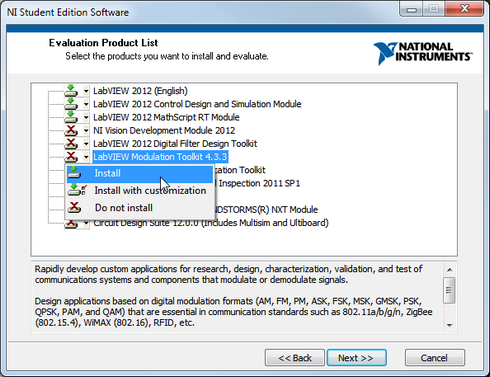Ni Software Installation Order
LabVIEW 2017 Help Edition Date: March 2017 Part Number: 371361P-01 » All Platforms • • • • • • Windows • • • • OS X • • Linux • • • • Installing the NI LabVIEW Application Builder (All Platforms) The instructions for installing the Application Builder depend on which package of LabVIEW you purchased. • LabVIEW Professional Development System—The LabVIEW Professional Development System includes and automatically installs the Application Builder.
Ni Software Installation Order Of Service
Toolkits add libraries of functions, VIs, interactive wizards, examples, utilities, and documentation to your NI LabVIEW installation, effectively reducing the time required to finish your task. These are accessible either through new palettes or menu entries in your development environment.

Therefore, you do not install the Application Builder separately. (Windows) During installation, the serial number for LabVIEW also activates the Application Builder. • LabVIEW Full Development System or Base Development System—If you also purchased the Application Builder, you receive a separate package for it. • (Windows) Install LabVIEW from the LabVIEW Platform media. Download film transformers 1.
During installation, you must enter a serial number for the Application Builder. Locate this serial number on the Certificate of Ownership in the LabVIEW Add-On Software package. If you do not activate the Application Builder during installation, it runs in evaluation mode. You can activate the Application Builder after installing LabVIEW from the License Status window that appears when you launch LabVIEW.
• (OS X and Linux) After you finish installing LabVIEW, insert the installation media for the Application Builder. Installing LabVIEW 2017 on a Computer That Already Has a Previous Version of LabVIEW (All Platforms) Installing LabVIEW 2017 does not overwrite previous versions of LabVIEW that are installed on a computer because each version of LabVIEW resides in a separate directory. To use files from the user.lib directory of a previous version of LabVIEW, copy those files into the user.lib directory of LabVIEW 2017. For detailed recommendations about upgrading VIs and projects from a previous version of LabVIEW, refer to the. Locating Missing Module or Toolkit Functionality (All Platforms) To use a module or toolkit with LabVIEW 2017, you must install a version of the module or toolkit that is compatible with LabVIEW 2017. Otherwise, the VIs, project items, dialog boxes, and other features associated with the module or toolkit do not appear in LabVIEW.